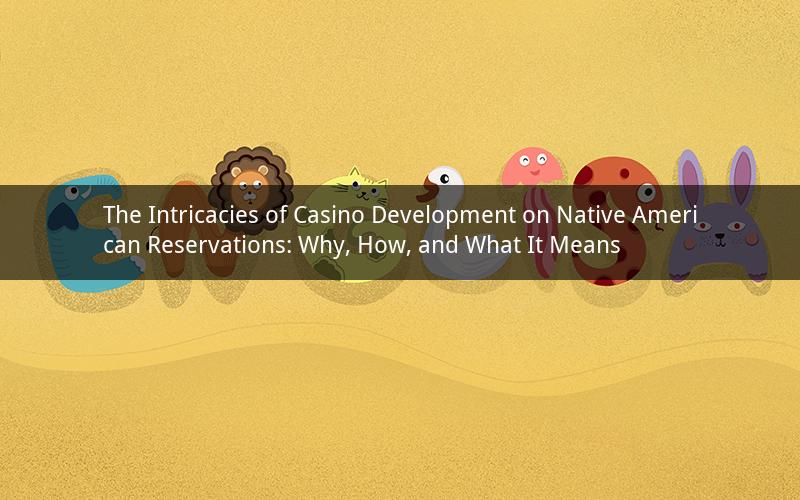
Casino development on Native American reservations has become a topic of significant interest and debate. This essay delves into the reasons behind this phenomenon, the process involved, and the implications it has for both the Native American communities and the broader society. By examining the historical, economic, and social factors, we aim to provide a comprehensive understanding of why casinos are built on reservations.
Historical Context
The roots of casino development on Native American reservations can be traced back to the Indian Gaming Regulatory Act (IGRA) of 1988. This legislation allowed tribes to operate casinos on their land, provided they had the necessary federal and state approvals. The IGRA was a significant step towards economic empowerment for Native American communities, which had long faced poverty and marginalization.
Economic Benefits
One of the primary reasons casinos are built on reservations is the economic benefits they bring to Native American communities. Casino operations generate substantial revenue, which can be used for various purposes, including infrastructure development, education, and healthcare. This financial independence allows tribes to invest in their communities and improve the quality of life for their members.
Moreover, casinos create job opportunities for Native American individuals, providing them with employment that may not be readily available in their local areas. This can help reduce unemployment rates and provide a stable source of income for families. Additionally, the economic impact extends beyond the reservation, as casinos attract tourists and contribute to local economies.
Social Benefits
Casino development on reservations also brings social benefits to Native American communities. The revenue generated from casinos can be used to fund cultural programs, preserve traditional practices, and promote cultural heritage. This helps to strengthen the identity and pride of Native American communities, fostering a sense of belonging and unity.
Furthermore, the establishment of casinos has led to increased educational opportunities for Native American children. Revenue from casinos can be allocated to scholarships, educational programs, and infrastructure improvements, helping to bridge the educational gap and provide a brighter future for the younger generation.
Legal and Regulatory Challenges
Despite the economic and social benefits, casino development on reservations is not without its challenges. Legal and regulatory issues often arise, as tribes must navigate complex federal and state laws. One of the main concerns is the potential for increased crime and gambling addiction, which can have negative impacts on both the reservation and surrounding communities.
Moreover, there is often tension between tribes and local governments, as casino development can lead to competition for resources and market share. This can result in disputes over land rights, tax revenue, and other issues, complicating the relationship between tribes and non-Native American communities.
Case Studies
To better understand the complexities of casino development on reservations, let's examine a few case studies:
1. The Navajo Nation: The Navajo Nation operates the Navajo Nation Gaming Enterprise, which includes five casinos. The revenue generated from these casinos has been instrumental in funding various tribal programs and improving infrastructure.
2. The Seminole Tribe of Florida: The Seminole Tribe operates seven casinos in Florida, generating significant revenue for the tribe. This revenue has been used to fund healthcare, education, and other essential services for tribe members.
3. The Pala Band of Mission Indians: The Pala Casino in San Diego, California, is one of the largest casinos in the United States. The Pala Band has used casino revenue to invest in their community, including funding scholarships, infrastructure projects, and cultural programs.
Conclusion
In conclusion, casino development on Native American reservations is a multifaceted issue with economic, social, and legal implications. While casinos bring significant benefits to tribes, such as economic empowerment, job creation, and cultural preservation, they also present challenges, including legal and regulatory hurdles and potential social issues. By examining the historical context, economic benefits, social impacts, and case studies, we can gain a deeper understanding of why casinos are built on reservations and the complexities involved.
Questions and Answers:
1. Question: How has the Indian Gaming Regulatory Act (IGRA) impacted Native American communities?
Answer: The IGRA has provided Native American communities with the opportunity to operate casinos on their land, generating substantial revenue for economic empowerment, job creation, and cultural preservation.
2. Question: What are the main economic benefits of casino development on reservations?
Answer: The main economic benefits include job creation, revenue generation for infrastructure development, education, and healthcare, and the potential for attracting tourists and contributing to local economies.
3. Question: How do casinos contribute to social benefits for Native American communities?
Answer: Casinos can contribute to social benefits by funding cultural programs, preserving traditional practices, providing educational opportunities, and fostering a sense of belonging and unity within the community.
4. Question: What are some of the legal and regulatory challenges faced by tribes when developing casinos on reservations?
Answer: Legal and regulatory challenges include navigating complex federal and state laws, addressing concerns over increased crime and gambling addiction, and resolving disputes with local governments over land rights and tax revenue.
5. Question: Can you provide an example of a tribe that has successfully utilized casino revenue to improve its community?
Answer: The Navajo Nation is an example of a tribe that has successfully utilized casino revenue for infrastructure development, educational programs, and cultural preservation.